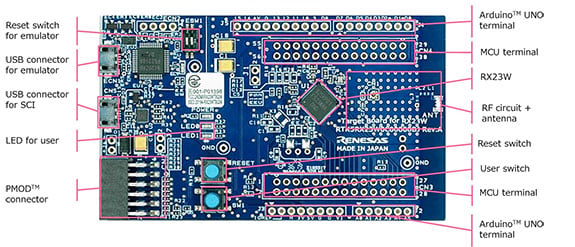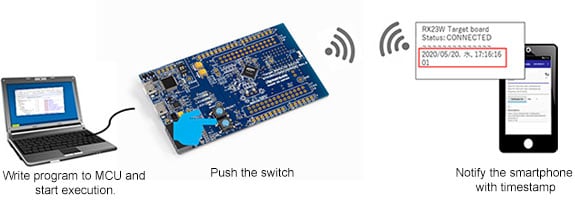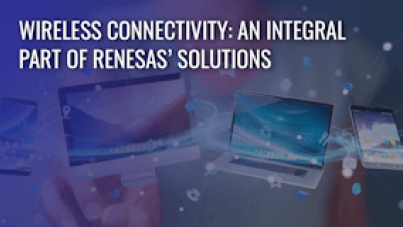The Renesas 32-bit proprietary core RX microcontroller was launched a decade ago. And, thanks to great support from all the customers, we are now celebrating the RX 10th Year Anniversary. For more than 10 years, I have been involved in the field of microcontrollers (as a programmer in assembly) at Renesas Electronics. I wish I could be the same age as RX in Renesas.
Over the past decade, we have been offering a number of attractive solutions that meet customers’ needs. I would like to introduce two ready-to-use solutions for wireless connectivity in the IoT society, which are a cloud solution that enabled cloud connectivity for edge devices, and a Bluetooth® 5 solution that allows interconnectivity within these edge devices.
In the past, customers were mainly interested in microcontroller specification, how to initialize and set each peripheral module as well as how to use and program the microcontroller. However, in recent years, there has been a trend to offer ready and easy-to-use solutions that have eye-catching demonstrations.
Cloud and Bluetooth 5 connectivity continue to expand their usage in offices, homes and production facilities. There will be more demand to obtain information wirelessly and save the data in the cloud for convenience. To obtain the information wirelessly, users can consider using Bluetooth 5, as its networks are built based on a Mesh topology that could connect to many devices and support wireless communications within 100 meters. By combining both the cloud and Bluetooth 5 solution, we can easily demonstrate an IoT system meeting the needs of the end-use requirement of gathering data from edge devices to the cloud.
First, let me introduce the cloud solution using an embedded microcontroller. The RX65N Cloud Kit makes it easy to evaluate the features used in IoT devices. It is a very popular kit, and we are increasing production to meet the demands.
Now, let’s try setting up this kit right away. It is very easy to set up and to make it more interesting, I would like to include an external sensor in the setup as shown in the picture.

The data sensed by the infrared sensor in the left picture is sent to the cloud, and the image on the right is then displayed in the web browser.
This is an example of creating a temperature check solution during the current COVID-19 situation. The infrared sensor is connected to an unused pin on the RX65N Cloud Kit. The only necessary correction on the software was the serial control section of the infrared sensor. No changes to the program source code are required for the MQQT communication protocol portion. Once built and executed, the infrared sensor data was received by the RX65N and sent to the cloud via MQTT communication. The temperature distribution of the transmitted data from the sensor looks like the above image on the right. This is a simple modification with no changes necessary on the troublesome cloud connection. In the future, human detection can also be realized using an infrared sensor based on Artificial Intelligence (AI)
Next, I will introduce a Bluetooth 5 Low Energy (LE) solution using the RX23W microcontroller (MCU).
Due to the availability of Bluetooth in smartphones, Bluetooth Low Energy has been widely used in numerous IoT devices.
RX23W is a 32-bit MCU supporting the full functionality of Bluetooth 5 LE. It has the capability of Bluetooth LE radio communications, system control and security in a single chip, implemented with a wide variety of peripheral functions in common with the Renesas RX family.
Unfortunately, the above concept has not yet penetrated the market. We have received a lot of inquiries about dedicated Bluetooth LE communication ICs. However, RX23W will become an over-specification for such usage. The RX23W is very suitable for cases where users want to add Bluetooth LE functions to the existing system or reduce the PCB real estate size by converting a two-chip solution (System controller + Communication ICs) into a single-chip solution.
Many developers may think that it is difficult to develop Bluetooth Low Energy. However, Renesas has prepared an environment to resolve this difficulty. Set up the RX23W Target Board (shown below) to start communicating with the smartphone.

Users are only required to use the RX MCU development environment and no additional development is needed for the Bluetooth software driver portion. Configuration of the Bluetooth setting in the Smart Configurator can be set easily in the same way as other peripheral functions through the GUI setting. This allows the Bluetooth drivers and program code for the peripheral functions to be generated easily.
Now that the drivers are developed, we will build the application part of the Bluetooth. The QE for BLE tool allows you to add and create profiles as easily as drivers, which is part of the defined Bluetooth communication protocol. There are two types of profiles: standard profiles that are pre-defined and custom profiles that you can create yourself. This is very useful because users do not need to develop from scratch. This time, I will define my own custom profile which creates a notification to be sent to the smartphone when a switch is toggled on the target board.
You can download the Renesas smartphone app called GATT Browser from the Apple Store/Google Play in advance on the smartphone. When I toggle the switch on the board, the CPU will be notified of the interrupt signal by the assigned IRQ. Once the CPU receives the interrupt signal, it will send a notification to the smartphone via Bluetooth, and the GATT Browser on the smartphone displays the notification. I was able to confirm that Bluetooth 5 LE communication was established based on my development.

The RX wireless connectivity solutions are here to lower the development hurdle for wireless communications. With the RX65N Cloud Kit and RX23W Target Board, you could shorten the development time by downloading the available tools from the website, and no longer need to develop the environment from scratch.
For more information, please refer to the RX 32-Bit Performance/Efficiency MCUs page.
The Bluetooth® word mark and logos are registered trademarks owned by Bluetooth SIG, Inc. and any use of such marks by Renesas Electronics Corporation is under license. Other trademarks and trade names are those of their respective owners.



